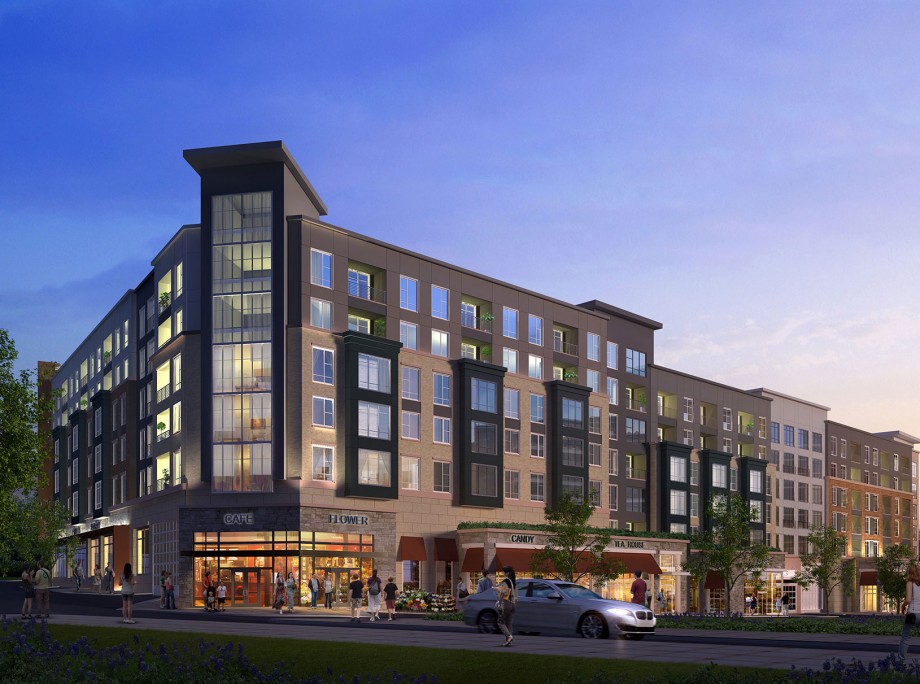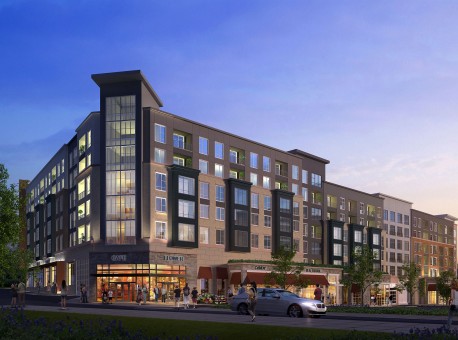Lincoln at Tinner Hill – Amenities arms race: Developers attract millennial renters with high-end features
Construction Dive
February 23, 2017
When prospective renters walk into the new seven-story, 285-unit West Broad Residences in downtown Falls Church, VA, a suburb of Washington, DC, they would be forgiven for asking the concierge if they’re in the right place. Multiple fireplaces flicker reassuringly and groups of stylish chairs and tables provide spots for quiet conversation. With a lobby recalling that of a luxury hotel, West Broad is emblematic of a trend in multifamily construction toward a bespoke fit and finish in common areas and a suite of luxury amenities that, together, aim to capture the eye of potential renters.
“This is the new normal,” said Rohit Anand, a principal at architecture and planning firm KTGY in Tysons, VA, which developed the amenities package at the five-story, 225-unit Lincoln at Tinner Hill apartment building located less than a mile from West Broad. Like West Broad, Lincoln’s amenities package includes garage parking, a swimming pool, a fitness center, a yoga studio, a multipurpose room and car-charging stations.
Although the two complexes compete for renters, their battle is part of a much bigger war — one that has been playing out across the country for the past few years. The battle is pitched over the need to attract millennials — the largest demographic cohort in the country today — who are voting with their wallets on the features that matter most to them when deciding where to live. And though developers are vying to attract their attention, fitting out their properties with features from yoga studios to dog-washing rooms to ports for their electric or hybrid cars, the race to the top is nearing its pinnacle.
Designing an amenities package
When it comes to choosing what amenities to include, “there’s a lot of push and pull,” said Stefan Gassner, development manager with West Broad developer Rushmark Properties. “We rely on consultants and property managers who are in tune with what the competition is doing and can make recommendations.” The amenities package changes as the master plan is studied and tweaked. “It’s a careful space-planning exercise,” he said, “because when you’re carving out space for amenities, you are giving back rentable space.”
He cites West Broad’s dedicated yoga room, complete with TVs that allow users to upload self-guided yoga programs, as one example. At 700 square feet, it’s about the size of a one-bedroom unit. “It turns out to be one of the most used and prized amenities in the building,” he said.
Another less obvious, but equally valuable, amenity is dedicated storage for resident packages. “When I tour older buildings, I rarely see enough space for receiving and storing packages, so they use a hallway or something,” Gassner said. West Broad, on the other hand, has a large, secure package storage room that includes a refrigerator for storing perishables. As online shopping grows, Gassner has reason to believe that adequate package storage will be a key feature in new, high-end multifamily communities.

Setting the tone in common areas is another important element.
Past West Broad’s lobby is a resident lounge featuring several large TVs, soft seating, a community bar and kitchen, and a large private room for events. A business center is outfitted with printers, and free Wi-Fi is available throughout the building’s common areas.
“When they take a tour of the building, we want potential renters to envision what it would be like to live there,” said Gassner, who credits interior designer Phyllis Hartman, founder and principal of Hartman Design Group, in Rockville, MD, for creating the atmosphere in West Broad’s communal spaces, which he likens to that of a boutique hotel. “We’re hoping they can imagine sharing a meal with friends on the terrace or hanging out in the lounge,” he said.
Millennial renters tend to favor communal amenities more than do previous generations, including co-working space, often managed by a third-party vendor, indoor-outdoor areas, and outdoor gathering spots with grills, fire pits and TVs. “Years ago, 20 square feet of amenities per unit was the standard,” KTGY’s Anand said. “Today that has nearly doubled to between 30 and 40 square feet.”
According to a 2015 survey of renter preferences from the National Multifamily Housing Council and real estate consulting firm Kingsley Associates, fitness spaces, high-tech features and communal gathering areas were of greater interest to millennials than to baby boomers. Nearly 60% of millennials included in the 120,000-person renter survey said they are interested in having a lounge area or party room in their apartment building, compared to 46% of baby boomer respondents who said the same. Other amenities favored more by millenials than by boomers include a fitness center (85.7% to 67.3%), community Wi-Fi (65.1% to 44.5%) and a resident portal for reserving community amenities (71.7% to 50.8%).
Looking at location
Determining what amenities are right for any one community can be a challenge. Anand dismisses national surveys of features renters want as too broad. His territory runs from Georgia to New England, with renters having different criteria within that swath. Instead, he references local surveys and psychographic studies completed by his firm’s developer clients.
Some luxury amenities can be pared back or skipped entirely if they already exist in the surrounding community. “Location is the No. 1 amenity,” Anand said. “If you have an urban neighborhood [that is] walking distance from restaurants, bars and cafés, then maybe you don’t need those things, or versions of them, inside your building.” He added that while land costs are higher for walkable urban locations, forgoing some of those repeated features can save on cost.
What’s not likely to get old? Proximity to public transportation and employment centers, along with garage parking, secure building access and on-site grocery retail.
West Broad, for one, is anchored by a 60,000-square-foot Harris Teeter grocery store at ground level, itself replete with a pizza oven, multiple self-service hot food bars and an in-store Starbucks. It references a recent trend toward grocery-anchored mixed-used developments.

An amenity that is a hit in one market might tank elsewhere. On-site car-sharing services are popular in some communities, while in others the bicycle maintenance room sees more use, said Daniel Gehman, studio director for Humphreys & Partners Architects based in Newport Beach, CA. Another example is soundproof band-practice rooms. “They may survive in communities that are located in very artsy neighborhoods but might not be used very often in other communities,” he said.
Dog-washing rooms with non-slip ramps to the tub and hair dryers may seem frivolous to some, but they serve the dual purpose of pampering the family pet and keeping units free of the mess that comes with washing a dog in the bathtub.
Here today, gone tomorrow
The amenities showdown started with communities competing for higher rents more than for renters, said Gehman, whose firm is strong in multifamily and mixed-use high- and mid-rise luxury communities. “We raised renters’ expectations and now have to provide this huge array of amenities just to get their attention,” he said. “What was once a luxury is now an entry-level amenity.” He notes that features like swimming pools, Wi-Fi lounges and clubrooms that used to be cutting edge are now commonplace.
Gehman and Anand agree that the race can’t go on forever. Multifamily amenities packages in new buildings are likely to be pared down at some point soon as developers take a closer look at what features are (and aren’t) making a positive contribution to their bottom line. Tastes change over time, and different groups of renters want different amenities.

“Millennials like to hang out with one another, so Wi-Fi and clubrooms are keepers,” Gehman said. “They may be on their tablets and laptops, but they enjoy doing it in a communal location.”
Spaces Gehman thinks might not make the cut are those that require a lot of space and offer limited benefits, such as sport courts and home theaters. Anand agrees. Due to their upfront cost and lack of flexibility in use, theater rooms are being replaced by large TVs in less formal lounge areas with moveable seating.
Anand is excited about the potential for apartments co-located with food and drink venues, such as a café open to the general public. In Washington, DC, for example, local coffee roaster Qualia is preparing to open a location at The Gale, a multi-building apartment complex in the District’s northwest quadrant that features many of the amenities offered by West Broad and Tinner, this spring.
He is less enthused by the prospect of drone landing stations and robotic package delivery services. “They’re not even close to being a reality [for mainstream projects],” he said. Gehman, on the other hand, is more optimistic about amenities with a high-tech edge making inroads in the market. “I could see it,” he said of robotic package deliveries.
A decade ago, multifamily community developers were competing on sustainability. “They were trying to out-green each other, then the recession came along and ended that. Renters didn’t want to pay for it,” Gehman said. “Now communities are competing on luxury, and it can’t last forever.”
Whether the next generation of renters will welcome the rise of the machines, renew the focus on green or continue to seek the lap of luxury is yet to be determined, but whatever the feature, developers seeking to fill their properties will need to buy in.

